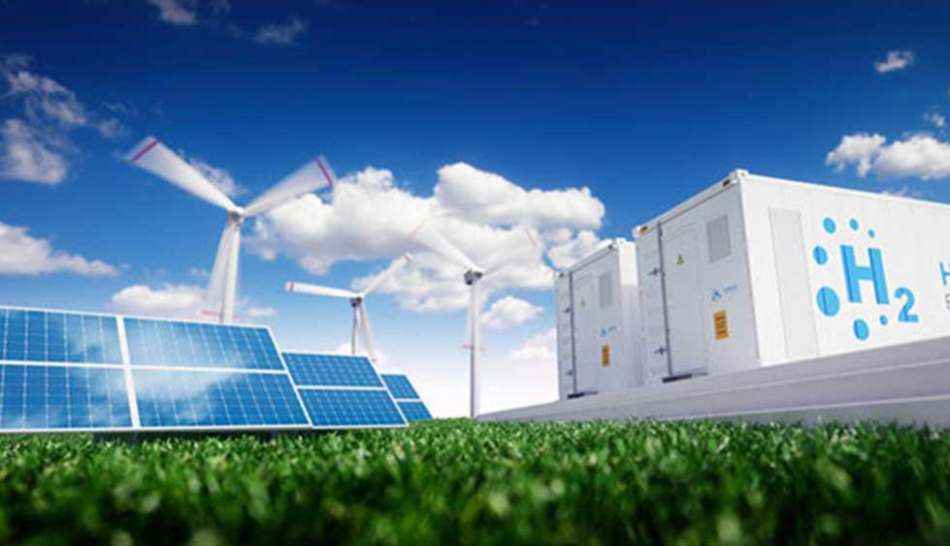A global race for the future fuel “hydrogen” .. Saudi Arabia seeks to lead in 2050

Hala Arafa - Beth:
Hydrogen has revolutionized the energy equation, which traditional fuel used to lead, and therefore it represents a future bet for many countries in achieving leadership in the field of energy, especially in the eastern Mediterranean region, and it is expected to play a major role in determining the regional center for energy in the future, especially since this trend Its growth is supported by many facts, including that it is able to achieve climate protection goals, as well as the adoption of hydrogen by many major countries and the formulation of strategies related to hydrogen, led by the European Union, as it is the highest in energy content compared to other types of fuel.
The race between the countries of the world in hydrogen production has started since its uses were linked to energy as a source of clean energy.
Hydrogen witnessed a revolution in uses, as a result of which it developed from a mere “raw material” that enters many industries into an “energy carrier” and “a direct source of clean fuels.” Since then, many countries in different countries of the world have taken rapid steps towards achieving leadership in This promising emerging market; Especially in light of what energy experts assert and their confidence in hydrogen's ability to accelerate the achievement of climate protection goals.
Energy experts say, "The world does not need to restructure the global energy system to achieve net zero carbon emissions, but what it needs only is hydrogen."
In this report, we can shed light on the journey of hydrogen since its discovery, the current position of the movement, and its future prospects.
Hydrogen was discovered and used as a fuel
The hydrogen journey began in 1671 AD; It was discovered by the British scientist Robert Boyle, but its uses did not appear until the beginning of the twentieth century in filling “airships” because it was lighter than air, as it was cheaper at the time than helium, which has the same property, but the explosion of a balloon in the United States The United States in 1937 prevented this.
The use of hydrogen as a fuel re-emerged with the founding of the US Space Agency (NASA) in 1958; Where the agency used it to support its missions to space, and the US space agency was able over a decade to develop its uses until it became a distinctive sign for the US space program.
The use of hydrogen in industry and its importance to reduce greenhouse emissions
Hydrogen currently has a huge market with the development of its uses that underlie many industries at the present time, but its use as a raw material is still limited to those industries such as the ammonia and methanol industry, as these industries are characterized by high investments and high demand.
As the talk about hydrogen has come back strongly over the past years, in the context of efforts to reduce greenhouse gas emissions, where hydrogen has seen a growth in its uses as a carrier / source of energy, and strong talk about its uses as an energy source and its ability to create a low-carbon energy future to reach goals carbon neutrality.
Hydrogen has more than one type and color
It was recently discovered that "hydrogen" has many types associated with several colors; They differ among themselves according to the source from which it is produced. There is black hydrogen, which is produced from coal, gray hydrogen, which is produced from fossil fuels by separating hydrogen from methane, and blue hydrogen, whose production is also similar to the production of gray and black hydrogen, but differs from them in the application of technology Carbon capture and storage for associated emissions, green hydrogen is environmentally friendly and produced through the electrolysis of water, yellow hydrogen is environmentally friendly and produced by the electrolysis of water using electricity generated from nuclear power plants, and turquoise hydrogen is produced through pyrolysis of natural gas or mass vitality in the absence of oxygen.
The current market size for hydrogen production
Looking at the current hydrogen market, global production during 2021 reached 120 million tons annually, an increase of 56% over 2018, which produced about 77 million tons.
Most of the current hydrogen is produced from traditional sources, as the contribution of fossil fuels to hydrogen production in 2018 amounted to about (99%), mostly from natural gas, which dominates about (76%) of the sources of hydrogen production, followed by coal by (23%) and with the hydrogen link With regard to climate protection issues, the contribution of fossil fuels (natural gas and coal) has gradually decreased to reach (95%) in 2021, which means an increase in the percentage of environmentally friendly hydrogen from (1%) to about (5%) during the period (2018-2021).
The importance of hydrogen as a promising market
Hydrogen has broad future prospects confirmed by the hydrogen demand market, where the global demand for hydrogen during the period (1995-2018) increased by (109%) to reach (115) million tons in 2018, compared to (55) million tons in 1995. The demand for hydrogen will grow annually during the period (2020-2044) at 35% and at an annual rate of 28% until 2050.
Many countries of the world have realized the truth of the importance of hydrogen as a promising market that can contribute to the process of energy transition and clearly reduce carbon emissions. These efforts have been reinforced by the European Commission's support for this approach; It launched the Hydrogen Strategy (Hydrogen Strategy for Climate-Neutral Europe) in 2020 with the goal of making widespread use of hydrogen possible by 2050.
As a result, many countries have begun to prepare visions and strategies to determine the paths that can be taken in building national economies for hydrogen, either for the purpose of providing hydrogen supplies (through local production or import), exploring areas/sectors in which it can be used, or for the purpose of studying investment opportunities. In hydrogen production for export to potential markets.
By the end of the third quarter of 2021, the number of countries that announced their national hydrogen strategy reached 16, after the United Kingdom and Colombia joined the list. The number of regional (Arab / African) countries that have expressed their interest in the hydrogen field has also increased to eight, including (7) Arab countries: the UAE, Saudi Arabia, Egypt, Morocco, Oman, Iraq, and Algeria, in addition to the state of South Africa, which announced a road map for it. in hydrogen.
The total number of hydrogen production and use projects announced by the end of the second quarter of 2021 reached about 359 projects with total investments of about $500 billion, and 80% of these projects are in the European market. However, hydrogen still faces challenges. Large production in storage and transportation, as well as high cost.
Arab countries enter the field of hydrogen production
According to the Organization of Arab Petroleum Exporting Countries (OAPEC), the number of planned hydrogen production and use projects has increased to (20) projects in Arab countries, including about (12) projects for the production of green hydrogen and green ammonia, and about (6) projects for the production of blue hydrogen and blue ammonia, and two projects for the use of green hydrogen and ammonia. Hydrogen as a fuel cell.
Saudi Arabia is competing for the lead in production
Saudi Arabia plans to set up a hydrogen plant on its northwest beaches, where those beaches enjoy year-round sunshine and wind that can power solar panels and windmills. One ton of green hydrogen is environmentally friendly, and it will become the largest produced in the world.
It is worth noting that Riyadh's pursuit of hydrogen production is part of its attempt to diversify its oil and gas-dependent economy and create job opportunities. As oil revenues occupied about 149 billion dollars from the Saudi budget for the year 2021.
The Kingdom is witnessing competition with the presence of Russia, the United Arab Emirates and many countries that are also seeking to obtain a share of the hydrogen market globally, as Russia aims to obtain 20% of the hydrogen market by 2030, while the United Arab Emirates announced the possibility of producing hydrogen from nuclear energy. To take advantage of the large capacity of the Barakah plant as well as the establishment of a hydrogen plant to gain a market share of 25% by 2030, Oman, Morocco and Egypt have also announced plans to establish plants.
On the same front, some analysts believe that if the Saudi market takes off as expected, green hydrogen revenues are expected to reach about $600 billion by 2050.
Egyptian plans to produce hydrogen
Egypt is among the list of countries that have already started preparing a hydrogen strategy, as a committee has been formed with the responsibility of preparing a national strategy for hydrogen production. Egypt has also announced several projects for the production of green hydrogen, green ammonia, blue hydrogen and blue ammonia, in order to achieve its vision of being a regional center for energy.



